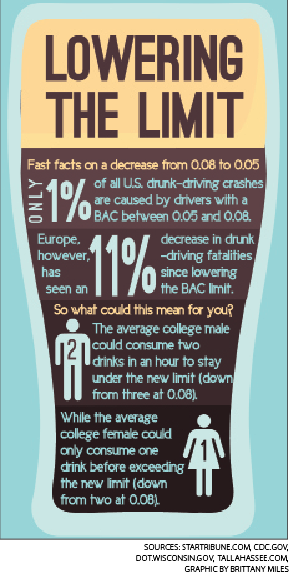
The National Transportation Safety Board is urging lawmakers to re-evaluate how much alcohol a person may consume and legally operate a motor vehicle.
The NTSB says lowering the legal blood-alcohol content will decrease highway deaths, but some say the proposal could make criminals out of drivers who consume very small amounts of alcohol at bars and sporting events.
Currently, motorists in North Carolina must have a BAC of less than .08 percent to legally drive. The NTSB voted in May to recommend lowering the limit to .05 percent.
A change like this hasn’t occurred in North Carolina since 1993, when the BAC limit was lowered from .10 percent.
About 10,000 people die in alcohol-related crashes every year in the U.S., according to the Centers for Disease Control and Prevention. That number has decreased since the BAC was last lowered nationwide, but it has remained constant for several years now. That’s why the NTSB says it is time for another reduction.
“This is critical because impaired driving remains one of the biggest killers in the United States,” NTSB chairman Deborah Hersman said in a May 14th press release.
According to research conducted by The University of North Carolina Highway Safety Research Center, it is possible that some motor skills are degraded at a BAC as low as .04 percent. After a person reaches a BAC level of .08, the chances of an automobile accident dramatically increase.
Because many students go to bars, sporting events and parties around campus, drunk driving is a perennial concern here at N.C. State. Lt. David Kelly, N.C. State’s Public Information Officer, said many things can influence somebody’s ability to drive, and it’s not always just about the number.
According to Kelly, drivers can be impaired by substances other than alcohol, and student drivers can be charged with a DWI even if their BAC is below .08 percent.
Regardless, Kelly said the University Police Department will enforce state law, whether the BAC limit is .05 or .08 percent.
The NTSB’s proposal has met pushback from some quarters. In a May 14th interview with the New York Times, Sarah Longwell, managing director of the American Beverage Institute, said the proposal would inhibit people from enjoying the social aspects of drinking,
“Moving from .08 percent to .05 percent would criminalize perfectly responsible behavior,” Longwell said. “Further restricting the moderate consumption of alcohol by responsible adults prior to driving does nothing to stop hard-core drunk drivers from getting behind the wheel.”
According to ABI, which represents more than 8,000 restaurants nationwide, more than 70 percent of all past alcohol-related deaths occurred when a person was impaired with a BAC above .15 percent.
Local bartender Lisa Lewis agrees that the NTSB’s proposal is excessive. Lewis has been a bartender at Mitch’s Tavern on Hillsborough Street for the past 13 year. She said lowering the legal BAC limit is not the right way to stop drunk driving.
She believes the people who are really causing the problem are driving without any regard for the law at all and are often way over the legal limit.
“There are degrees of drunkenness, and I feel like the people that are killing people are blowing like a .19,” Lewis said.
Lewis was bartending the last time the BAC level was lowered from .10 percent 20 years ago. She acknowledged that it did seem to raise consciousness among responsible drinkers. Although that may happen again, Lewis said that if the new law is passed it will only harm the social drinkers—and they’re not the problem.
While many organizations are backing the NTSB’s proposal, there is one notable group absent from that list.
Mothers Against Drunk Driving, the largest nonprofit in the country that works to protect people from drunk driving, has said that while they would not be opposed to a lower legal BAC, they want to focus their efforts in other areas.
MADD believes the most effective way to prevent drunk driving is to punish previous offenders and implement technology to keep those drivers off the road, according to May 14th article by The New York Times.
These measures include mandatory breathalyzers and steering locks after the first offense. With these units installed, a convicted drunken-driver would not be allowed to start their car if they had been drinking.
If the BAC level is ultimately reduced, history suggests that the change may not come quickly. The NTSB originally suggested lowering the legal BAC limit to .08 in 1982, and it wasn’t until 2004 that all of the states made the change.